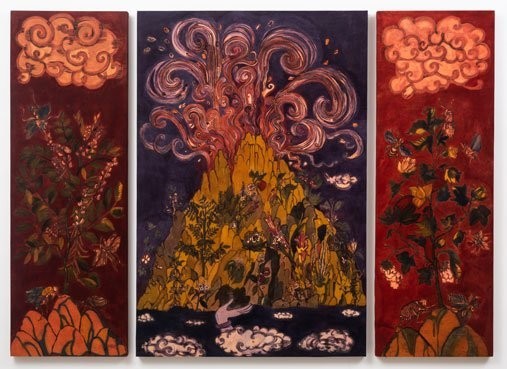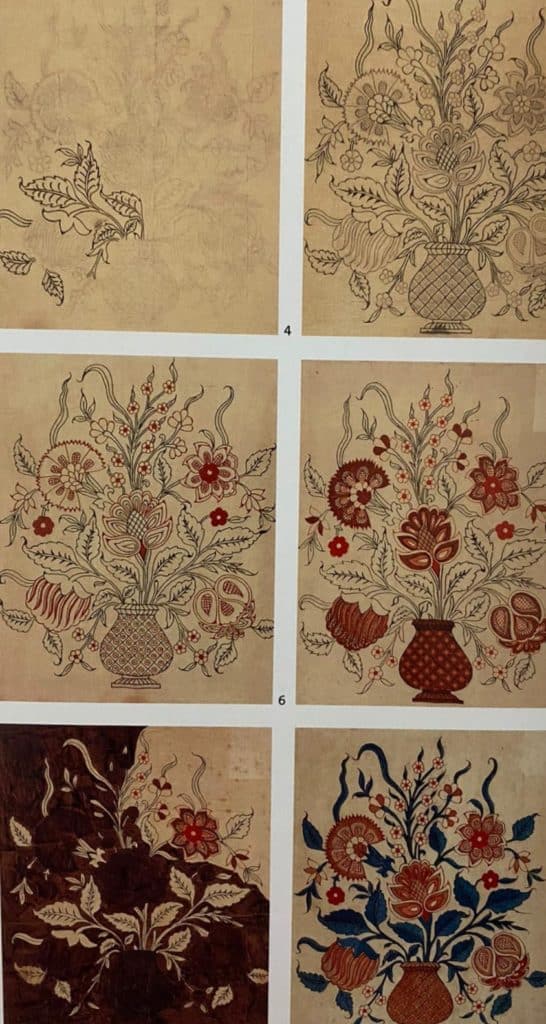I will start teaching my first course on ‘Collaborative Design with Artisans’ as an Adjunct Professor at FIT from the coming Saturday. This new opportunity encouraged me to read about handmade textiles from a global perspective. I read some exciting books from the V&A Museum’s Textile and Fashion collections. It is a very enriching experience to learn from other cultures. This reading and research have helped us enhance our design approach and library at Marasim. As I am hopeful, it will also help further the knowledge of my soon to be students.
Jacobean Embroidery : We live in our current times in houses or apartments, which are fully furnished, heated in winter, and adorned extensively with textiles for aesthetic reasons and utility. But there was a time in England and the rest of the world that houses were draughty, furniture scarce, and cloth was restricted to wool, linen, and silk. There were rushes on the floor, which dogs and often people would relieve themselves in, making interiors malodorous. People often shifted from one house to another, an itinerant lifestyle because homes became quickly unhygienic.

Bābur supervising the laying out of his Charbagh The Garden of Fidelity. Opaque watercolor and gold on paper
India – ca.1590
Artists: Bishndas and Nanha From the V&A
Mughal Floral Designs – South Asian art has always been full of floral images, but this reached its zenith in the Mughal empire. During the 330 years that the dynasty ruled, most magnificent art, architecture, and craft that the world has seen were produced, and much imagery used was from flora, particularly in the reigns of Jahāngīr and Shah Jahan. However, Bābur, Humayun, and Akbar are all recorded as profoundly interested in gardens and flowers. One of Babur’s first actions in India was to make a garden, the Charbagh.
The popularity of floral motifs in Mughal art was because traditionally, living creatures and humans were not supposed to be depicted in Islamic art. Therefore, the plant kingdom provided subjects that were non-controversial and capable of stylization.
The Origin of Madras Checks Fabric
Around the 12th century, Madras Checks was a piece of handloom clothing for India’s peasant class in the village called Madraspatnam (Madras now Chennai). The local weavers would extract the soft fibers from the “tip-skin” of native trees to weave 36″ wide square handkerchiefs, which were then block printed with bright colored check patterns. They were worn as a garment similar to a sarong wrapped around the waist and extending to the ankles, called a lungi.
Last week, I had written about dyes extracted from animals. In continuation of the story of natural dyes, I will describe the primary dyes extracted from plant sources and the often violent history associated with at least one of these. (more…)

The Story of Indian Kalamkari : Imagine a textile that is traditionally hand-painted with a bamboo pen, has a history which goes back 3000 years, and was partly instrumental in India losing her independence. That is Kalamkari, with its Persian root ‘Ghalam’ or pen, and ‘Kari’ or craftsmanship.
Kalamkari in its current form, where resist dyed fabrics are hand painted, is believed to have originated in the 8th century AD, though painted fabrics have been discovered in the Indus Valley Civilisation. This was a time when religious traditions and tales from Hindu mythology were handed down orally by itinerant minstrels, similar to traditions in Europe. Kalamkaris with depictions of tales from Hindu mythology, were a visual aid to these minstrels. In a sense, their purpose was similar to the stained glass of churches in Europe.
Until 520 years ago, the Europeans had known only linen and silk as compared to at least 5,000 years ago when Indian farmers had already started domesticating a species of tall tree cotton. And Indian weavers had already started weaving soft, washable, lightweight cotton that held colors well.
The start of Painted and Printed Cotton trade with Europe
By the time, the first European ships arrived in India in the 1500s. The Indian artisans’ had already for thousands of years combined skills in weaving, painting, printing, dyeing, bleaching, and glazing cotton to embellish their superior fabrics for thousands of years. Nonetheless, after the European ships returned from India with the first few samples of the lightweight, washable, gaily colored and patterned cottons, they became a fashion sensation! These cottons were a starting point for the start of the textile trade between India and West.
It is a point of wonder that ancient Indian artisans came to master and dominate the art of making colors and mordants with the use of humble natural ingredients like rusty nails, and plant parts—such as roots, seeds, and powdered leaves. The durability and vibrancy of which can be justified by looking at the thousands of years old specimens of larger than life hand painted or printed Indian cottons displayed at the best museums around the world.






